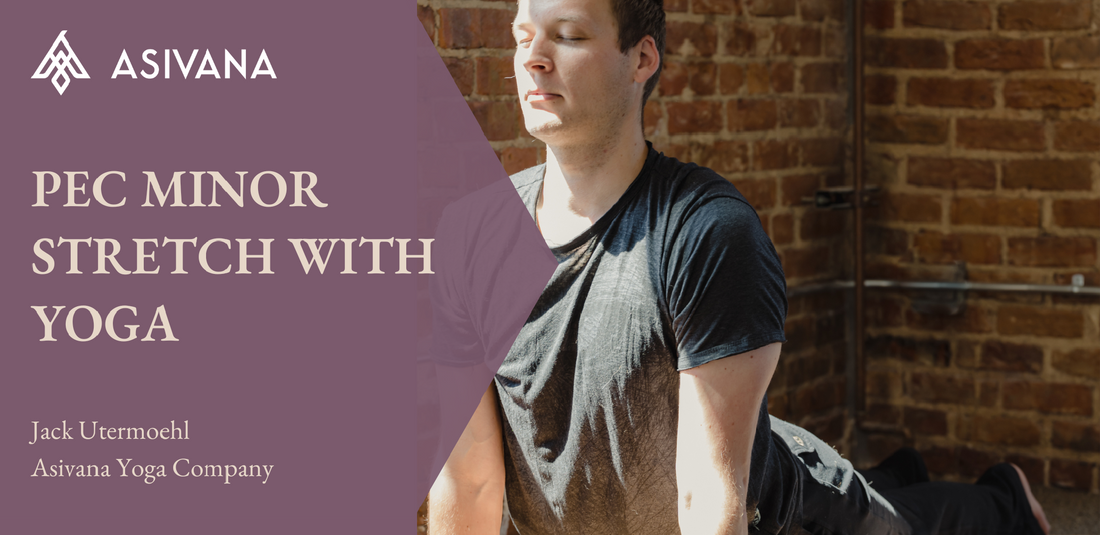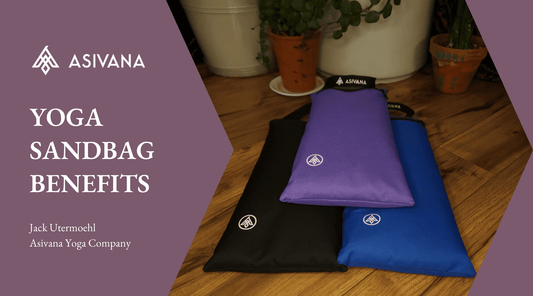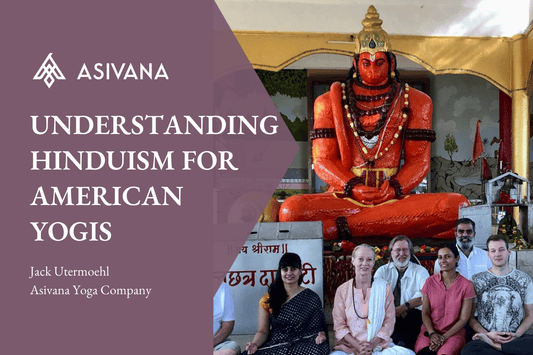
The Ultimate Pec Minor Stretch: Yoga Sequence
Jack UtermoehlWelcome to our Pec Minor Stretch Guide!
If you've ever experienced tightness in your chest or shoulders, this blog post is for you. I'll dive into the world of the pec minor, a small but mighty muscle that plays a significant role in your upper body health and posture. By understanding the pec minor and how to stretch it, you can improve your overall mobility and prevent discomfort in your chest and shoulder area.
In this comprehensive guide, I'll cover what the pec minor is and why it's essential to give it some TLC. I'll also provide step-by-step instructions on how to perform various yoga poses that target the pec minor, as well as a holistic yoga sequence designed specifically to stretch this underrated muscle.
If you're already familiar with the pec minor and just want to dive into the yoga poses, feel free to skip ahead to the "Yoga Poses for Pec Minor Stretch" section. For those who want to learn more about the pec minor and its importance.
Get ready to expand your knowledge, improve your practice, and give your pec minor the attention it deserves!
The Pec Minor: What is it and why is it essential to stretch?
Say hello to the pec minor, a small but mighty muscle that plays a big role in your upper body health and posture. Think of it as the unsung hero that supports your chest and shoulders, helping you move and breathe with ease.
The pec minor is that little muscle sitting right beneath its bigger sibling, the pec major. It's like the sidekick that doesn't get the spotlight but is essential to the team. It keeps your shoulders stable and ensures they move smoothly through various motions.
Now, if you're not into nerdy muscle talk, feel free to skip ahead. But if you're curious about the nitty-gritty details of the pec minor, buckle up because we're about to geek out on this fascinating muscle!
The Technical Lowdown
The pectoralis minor is a triangular-shaped muscle that originates from the third to fifth ribs and attaches to the coracoid process, a small bony projection on the scapula (shoulder blade). It has several key functions, including stabilizing the scapula, pulling it downward and forward, rotating it downward, and helping to elevate the ribs during deep breathing.
By understanding the pec minor and giving it the attention it deserves, you can keep your posture on point, your shoulders mobile, and your upper body feeling great. So next time you're on the mat or at the gym, give a little nod of appreciation to the pec minor – the unsung hero of your chest and shoulders!
Functions of the Pec Minor
The pec minor has several essential functions that contribute to the proper movement and support of the upper body:
Scapular stabilization: The pec minor helps stabilize the scapula by anchoring it to the ribcage, ensuring proper shoulder alignment and function.
Scapular depression: It assists in pulling the scapula downward, which is necessary for various arm movements, such as reaching overhead or behind the back.
Scapular protraction: The pec minor also contributes to scapular protraction, moving the shoulder blade forward and around the ribcage. This movement is essential for tasks like pushing or throwing.
Scapular downward rotation: It plays a role in rotating the scapula downward, which occurs during activities like lowering the arms from an overhead position.
Rib elevation: During deep inhalation, the pec minor helps elevate the ribs, facilitating proper breathing and expanding the chest cavity.
Importance of Stretching the Pec Minor
Stretching the pec minor is crucial for maintaining good posture, shoulder mobility, and overall upper body health. Due to our modern sedentary lifestyles, which often involve prolonged sitting and hunching over electronic devices, the pec minor can become tight and shortened. This tightness can lead to several issues:
Poor posture: A tight pec minor pulls the shoulder blades forward and down, causing rounded shoulders and a hunched posture known as kyphosis. This misalignment can strain the neck, upper back, and shoulder muscles, leading to discomfort and pain.
Shoulder impingement: Tightness in the pec minor can reduce the subacromial space in the shoulder joint, potentially leading to impingement of the rotator cuff tendons and increased risk of injury.
Reduced range of motion: Limited flexibility in the pec minor can restrict shoulder movement, particularly in overhead and reaching movements, affecting daily activities and athletic performance.
Muscular imbalances: When the pec minor becomes tight and overactive, it can inhibit the function of opposing muscles, such as the rhomboids and lower trapezius, leading to muscle imbalances and further postural issues.
Yoga Poses for Pec Minor Stretch
Prone Pectoralis Stretch
The prone pectoralis stretch is a simple and effective stretch for the pec minor, helping to open the chest, improve posture, and alleviate shoulder pain.
Instructions: Lay prone with your heart to the mat and with one arm extended at a 90-degree angle (straight out from the shoulder). Place the hand of the opposite arm on the mat next to your shoulder and roll onto the side of the body with the out-stretched arm until you feel a stretch in the front of your shoulder and chest. Hold this position for 20-30 seconds and then switch sides.
Modifications: You can have your elbow bent at a 90 degree angle for a different feel. One or both of your feet can be flat on the ground in your twist.
Extended Puppy Pose (Anahatasana)
Extended Puppy Pose stretches the pec minor, as well as the shoulders and spine, promoting better posture and chest expansion.
Instructions: Begin on all fours in tabletop pose with shoulders over wrists and your hips over knees. Slowly walk your hands forward, lowering your heart towards the ground while keeping your hips above your knees. Allow your forehead or chin (if the neck is ok with this) to rest on the floor or a yoga block, and hold the pose for 30 seconds to 1 minute.
Modifications: You can place a block under the heart for less or bring your elbows to blocks and hands in prayer pose above your head for more.
Camel Pose (Ustrasana)
Camel Pose stretches the pec minor, while also opening the chest and shoulders. This pose can help to relieve tension and tightness in the upper body.
Instructions: Kneel on your yoga mat with your knees hip-width apart. Place your hands on your lower back, fingers pointing up or down. Gently lean back, opening your chest and drawing your shoulder blades together. If comfortable, reach back and hold onto your heels or place your hands on yoga blocks beside your feet. Keep your hips aligned over your knees by pressing the hips forward and lift through your heart. Hold for 20-30 seconds, then slowly release. Repeat 1-3 times. Release the tension in the spine by going into a child's pose.
Modifications: If this causes pain in the back or you feel unstable in the pose, skip it.
Bridge Pose (Setu Bandha Sarvangasana)
Bridge Pose stretches the pec minor, strengthens the back muscles, and opens the chest and shoulders.
Instructions: Lie on your back with your knees bent and feet hip-width apart. Place your arms alongside your body, palms facing down. Press your feet and arms into your mat and lift your hips towards the ceiling, engaging your glutes and thighs. Optionally, clasp your hands under your hips and roll your shoulders under to lift your chest higher. Hold for 30 seconds to 1 minute, then slowly lower your hips back to the mat. Repeat 1-3 times.
Modifications: You can place a block (or two) under the sacrum for a supported bridge pose. Hold the support bridge for 5 minutes.
Bow Pose (Dhanurasana)
Bow Pose stretches the pec minor and opens the chest, while also strengthening the back muscles.
Instructions: Lie on your stomach with your arms by your sides. Bend your knees and reach back to grab your ankles or the tops of your feet. Inhale kicking your feet into your hands lifting your chest and thighs off the ground, creating a bow shape with your body. Keep your gaze forward and your neck relaxed. Hold for 20-30 seconds, then gently release. Repeat 1-3 times then windshield wiper your legs to release tension in the lower back.
Modification: If this causes pain or is not accessible in your body at this time then skip it.
Cow Face Pose (Gomukhasana)
Cow Face Pose stretches the pec minor, while also opening the shoulders and chest.
Instructions: Sit on your yoga mat with your legs crossed stacking the knees with your feet by your side or slightly wider. If your right leg is on top, bring your right arm behind your back and your left arm overhead, reaching for your right fingertips. If you cannot reach your fingers, hold onto a yoga strap or towel between your hands. Draw your elbows in opposite directions and breathe deeply. Hold for 30 seconds to 1 minute, then switch sides.
Modifications: You can sit in a hero's pose with shins on the mat and sit bones on the heels or a block instead of crossing the legs.
Eagle Pose (Garudasana)
Eagle Pose stretches the pec minor, opens the shoulders, and improves balance.
Instructions: Stand on your yoga mat with your feet hip-width apart. Cross your right leg over your left, either wrapping your foot behind your left calf or placing your toes on the ground for balance. Cross your left arm over your right and bend your elbows, bringing your palms together or touching the backs of your hands. Lift your elbows while keeping your shoulders relaxed. Hold the pose, maintaining your balance and focus. Hold for 15-30 seconds, then switch sides.
Modifications: For less, focus on the arms and stand with feet hip width distance apart. For more lift the elbows and press the hands away from you coming into a small backbend.
Fish Pose (Matsyasana)
Fish Pose stretches the pec minor and opens the chest, while also relieving tension in the neck and shoulders.
Instructions: Lie on your back with your legs extended and your arms alongside your body, palms facing down. Press your forearms and elbows into the ground, and lift your chest towards the ceiling, creating an arch in your upper back. Allow your head to gently rest on the ground, keeping your neck relaxed. Duration: Hold for 15-30 seconds, then slowly release.
Modifications: Place a block under the thoracic (upper) spine and let the head relax down towards the mat. You can place a second block under your head at a lower setting than the block behind the back. If supported, hold for 1-5 minutes.
Integrate these poses into your yoga practice to effectively stretch your pec minor, improve posture, and alleviate tension in the chest and shoulders. Remember to listen to your body and modify poses as needed.
A 20-minute Sequence for Pec Minor Stretch:
- Warm-up: Begin your practice with a few rounds of Sun Salutations (Surya Namaskar) to warm up the body and prepare it for the pec minor stretches. (5 minutes)
- Extended Puppy Pose (Uttana Shishosana): Move through a few cat/cow cycles then from tabletop pose walk the hands forward lowering the heart to the mat. (3 minutes)
- Camel Pose (Ustrasana): Walk your hands back through tabletop pose onto your knees. Support your low back as you lift your heart and bend backwards. Release with a child’s pose. (1-2 minutes)
- Cow Face Pose (Gomukhasana): Bring your legs forward and cross stacking your knees. Reach your opposite hand overhead and the other behind the back. Roll the shoulders to release. (1-2 minutes)
- Fish Pose (Matsyasana): Place your block behind the thoracic spine and release the head over the block. Roll to one side and remove the block. (1-5 minutes)
- Cool-down: End your practice with Savasana, allowing your body to absorb the benefits of the pec minor stretches. (5 minutes)
Invest in Your Practice Today with Asivana
Experience the benefits of pec minor stretching by integrating these poses into your yoga routine. Enhance your practice further with Asivana's specially designed yoga products that support your journey both on and off the mat.
Asivana offers a range of high-quality EcoBlocks, comfortable yoga straps, and other thoughtfully crafted products to elevate your practice, whether you're a seasoned yogi or a beginner.
Don't let tightness or discomfort hold you back. Embrace a pec minor stretch for improved posture, reduced pain, and better overall well-being. Visit Asivana's online store today and find the perfect accessories to support and transform your practice.













